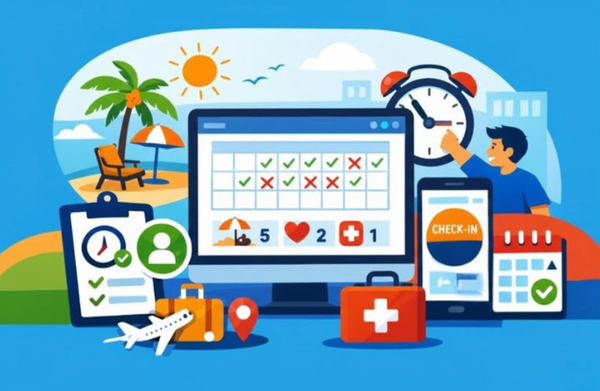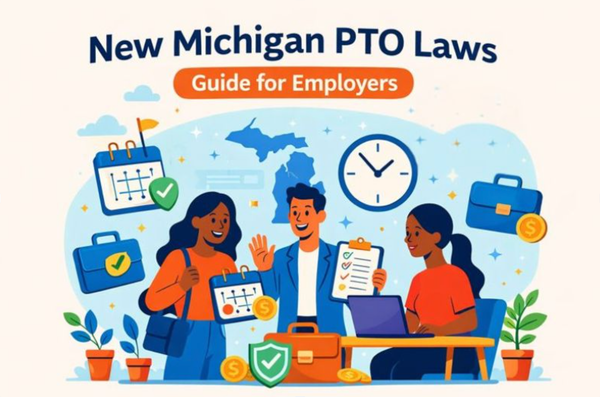5 Ways Predictive Analytics Improves Employee Retention
Discover how predictive analytics can enhance employee retention through tailored strategies, improved HR decisions, and increased satisfaction.

Discover how predictive analytics employee retention strategies help HR teams keep top talent through tailored plans, better decision-making, and improved satisfaction.
Table of Contents
- Spot flight risks early
- Create custom retention plans
- Make better HR choices with data
- Improve employee satisfaction
- Plan better for future leaders
- Conclusion
- FAQ
Summary at a Glance
Let's break it down:
| Way | How It Works | Impact |
|---|---|---|
| Spot flight risks | Analyzes work patterns, engagement | Flags potential quitters before they leave |
| Custom retention plans | Groups employees, tailors strategies | Addresses specific needs of different groups |
| Better HR decisions | Uses data for hiring, compensation | Cuts costs, improves talent management |
| Boost satisfaction | Tracks engagement, personalizes experiences | Increases overall employee happiness |
| Plan for future leaders | Identifies high-potential employees | Ensures strong leadership pipeline |
Bottom line: Predictive analytics gives HR teams the insights they need to keep top talent happy and productive. It's not about spying—it's about understanding your team better so you can create an environment where they want to stay and grow.
Related video from YouTube
Spot employees likely to leave
Predictive models can flag turnover risk before employees quit. They pull from historical data and employee engagement scores, using statistical algorithms to identify patterns that show disengagement.
Here's the deal:
These models analyze data from various sources to flag flight risks. Through data analysis, predictive analytics enables organizations to spot early warning signs. They look at:
- Time off patterns
- Project engagement
- Work performance
- Life changes
An employee who suddenly takes more time off or avoids long-term projects? They might be job hunting.
But it's not just about behavior. The models also consider:
- Time in current role
- Last promotion date
- Salary vs. market rate
Deloitte put this into action. They built a model using three years of employee data, assigning each worker a retention score from 1 to 100. This helps managers focus on high-performing, high-risk employees and gives business leaders the actionable insights needed to reduce turnover.
Visier, an analytics company, claims its tool is up to 17 times more accurate at predicting resignations than guesswork. That's huge for HR teams.
"Action predictive analytics is technology that learns from experience (data) to predict the future outcomes of individuals in order to drive better decisions." – Eric Siegel, Author
Use these predictive insights to catch issues early, address underlying concerns, and keep your best people on board.
Create custom retention plans
Predictive analytics helps HR teams craft tailored strategies to keep employees happy and engaged. It's not one-size-fits-all anymore.
Here's how it works:
These tools analyze data points about your workforce, including:
- Time in role
- Performance ratings
- Salary vs. market rates
- Engagement survey responses
They group employees with similar traits and needs, letting HR create targeted strategies and long-term retention initiatives.
Take Zillow, for example. After a big merger, they set up a listening program to understand what mattered most to their staff. The top concern? Career growth.
Zillow gave managers a playbook to better support employee expectations around development. The result? Higher scores for career opportunities and improved retention.
But it's not just about climbing the ladder. Predictive models can spot other retention analytics insights too:
| Employee Group | Potential Risk | Tailored Strategy |
|---|---|---|
| New hires | Early turnover | Priority follow-ups in first 3 months |
| High performers | Burnout | Flexible work options, wellness programs |
| Mid-career pros | Lack of growth | Mentorship, skill development plans |
| Working parents | Work-life balance | Enhanced family benefits, flexible schedules |
The key is to mix and match. Combine demographics with behavior patterns to create unique groups. Then, design retention plans that speak directly to their needs.
Bright Horizons, a childcare provider, nailed this approach. They listened to employees at every stage of their journey with the company. One big takeaway? Teachers wanted more education opportunities.
So, Bright Horizons started offering tuition help for staff pursuing higher degrees. Within a year, 80% of employees said they saw a future with the company. That’s a clear win for retention and a good example of how predictive analytics can guide proactive strategies that strengthen engagement.
The goal is to understand your team better so you can create an environment where they want to stay and grow, ultimately building a more satisfied workforce.

Make better HR choices with data
HR teams now use data to make smarter workforce management decisions. No more guesswork.
Here's how predictive analytics helps HR:
1. Spot hiring trends
HR can see which job posts attract top talent. This helps them craft better job descriptions and choose the right platforms during the hiring process.
HireVue's machine learning system analyzes video interviews. It's helped Unilever cut hiring time by 90% and save £1m yearly.
2. Find future stars
Data uncovers high-potential employees who might be overlooked. HR can then create succession strategies to keep these rising stars engaged.
3. Predict and prevent turnover
By analyzing employee data patterns, HR can spot who's likely to leave before they do. This allows for a proactive approach.
Here's how different data points might signal potential turnover:
| Data Point | What It Might Mean |
|---|---|
| Sudden drop in productivity | Employee may be disengaged |
| Skipping team events | Possible lack of connection with coworkers |
| Increased time off | Could be job hunting |
| Late to meetings | May show decreased commitment |
4. Improve onboarding
Data from successful employees shapes better onboarding programs. This sets new hires up for success from day one and helps identify employees who need early support.
5. Create fairer pay structures
Analytics can reveal pay gaps and ensure fair compensation. That not only improves morale but also helps reduce turnover by staying aligned with employee feedback and expectations.
The goal? Give HR teams better insights, not replace human judgment. With the help of data scientists, HR gains valuable insights and key metrics that inform better business strategy.
Ed Barry from Gallagher says:
"One of the best uses of predictive analytics is to help employers connect the dots between employee behavior and retention or attrition."
Improve employee satisfaction
Predictive analytics boosts employee satisfaction and retention. Here's how:
- Spot issues early: Analyze employee surveys and reviews to catch problems before they grow.
- Personalize experiences: Use data to tailor benefits and development plans aligned with engagement strategies.
- Track engagement: Regular surveys help measure and boost engagement trends.
| Data Source | Insights | Action |
|---|---|---|
| Pulse surveys | Low team morale | Plan team-building |
| Performance reviews | No growth chances | Create personal growth plans |
| Time tracking | Too much overtime | Balance workloads |
Adobe's "Check-In" program uses data to drive targeted improvements. Gloria Chen, Adobe's Chief People Officer, says:
"Feedback and ongoing conversations between managers and employees are key to check-ins' success - they give employees clarity for their roles and support career growth."
When using AI-driven predictive analytics, companies can identify trends early, connect job performance with development, and drive continuous improvement. This helps build a more satisfied workforce and long-term organizational success.
Plan better for future leaders
Predictive analytics helps companies prepare for future management needs. Here's how:
Spot hidden talent: Analytics uncover employees with leadership potential who might be overlooked. This includes high performers in non-management roles, employees with diverse experiences, and those with strong influence (identified through Organizational Network Analysis).
Create targeted development plans: Companies can tailor training programs for future leaders by analyzing skills gaps and performance metrics.
| Current Skills | Needed Skills | Development Plan |
|---|---|---|
| Technical expertise | Strategic thinking | Leadership workshops |
| Team management | Change management | Mentoring program |
| Project execution | Financial acumen | MBA sponsorship |
Align succession plans with company goals: Use data to ensure future leaders fit long-term business objectives. Match candidate skills to projected business needs, identify critical roles, and assess retirement risks among current leaders.
Improve diversity in leadership: Analytics can track and boost diversity in the leadership pipeline. Set targets for diverse candidates, monitor inclusion initiatives, and identify biases in promotion practices.
Measure development effectiveness: Track how well leadership programs work by analyzing changes in readiness levels, performance improvements after training, and retention rates of high-potential employees.
Energy company npower used data-driven methods to identify and develop 168 middle managers for senior roles. Victoria Buckenham from npower's parent group RWE said:
"The lesson we learned is that paying lip service to talent management isn't enough. You have to bring it to life and show it's not just a tick-box exercise. For any organisation that wants to succeed, keeping managers motivated and driving talent through the ranks will be vital."
Conclusion
Predictive analytics is changing the game for HR departments. Here's how it boosts employee retention:
- Spots potential leavers
- Creates personalized retention strategies
- Improves HR decision-making
- Boosts job satisfaction
- Helps plan future leadership
What's next for HR analytics? We're talking AI, machine learning, and a deeper focus on employee experience. Companies like Cisco and Google are already seeing results.
"Information is power. It can allow companies to make better human resource decisions." - Michael Lieberman, Founder of Multivariate Solutions
The HR analytics market is set to hit $3.6 billion by 2025. But remember: data should support, not replace, personal connections with employees.
Want to make the most of HR analytics? Build a solid data foundation, invest in tech, foster a data-driven culture, team up across departments, and keep tweaking your approach.
FAQ
What is predictive analytics for employee retention?
Employee retention predictive analytics uses workforce data and statistical models to forecast which employees might leave. By recognizing early warning signs, HR managers can proactively address retention challenges with planned actions instead of reacting after employee turnover happens.
What are the 3 R's of employee retention?
The 3 R’s are Recruitment, Recognition, and Retention. Together, they emphasize how careful hiring, ongoing appreciation, and long-term support keep employees engaged. Modern data-driven retention strategies help companies go beyond these basics and design more personalized, proactive retention strategies.
How to predict employee retention?
Organizations collect data such as engagement scores, performance data, promotion history, and even turnover rates. By analyzing these patterns, HR can leverage predictive analytics to identify employees at risk of leaving and design interventions that improve satisfaction and reduce turnover.
Is predictive analytics only useful for customer retention?
Not at all. While it started in customer-facing industries, predictive analytics is now critical in HR. Companies use it to enhance employee engagement, strengthen workforce planning, and guide retention initiatives in response to modern industry trends.




